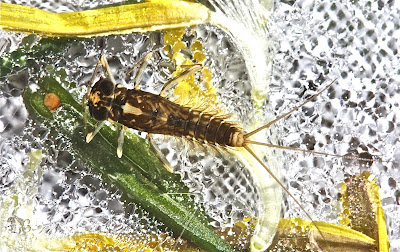One of those rare days when I actually found the nymph for which I was looking! This is the flatheaded mayfly Cinygmula subaequalis. It's only the third nymph that I've found. The first one was in Entry Run up in Greene County, and this one, like number two, is from one of our small mountain streams in Sugar Hollow.
In their important book -- Mayflies: An Angler's Study of Trout Water Ephemeroptera -- Knopp and Cormier, speaking of the Cinygmula species note that they "are not considered important mayflies by many western fly fishers." I suspect the same is true in the east. The nymphs themselves are very small. The one in the photo at the top of the page was only 6 mm, and you can see by the length of the wingpads that it's fairly mature.
Beaty describes C. subaequalis -- the only species that we find in the east -- in the following way: "Front of head incised medially; maxillary palpi protrude at side of head; all gills on segments 1-7 similar in size and shape...; three caudal filaments." "In high quality mountain streams." He adds that "Specimens of C. subaequalis may be reddish in color (especially early instars) or otherwise have variable color patterns." ("The Ephemeroptera of North Carolina," p. 17) I've noted those features before in previous entries: 3/27/12 and 5/4/14. Once again, here are the nymphs. The maxillary palpi are quite distinctive.
_________________
But as we have seen, this is a genus we also find in the west. In fact, according to Knopp and Cormier, "Entomologists have recorded ten Cinygmula species from western waters, and [only] one species, C. subaequalis, on eastern waters." (p. 171) And as it turns out, one of the nymphs that I found in Montana was a Cinygumla.
This too was found in a "high quality mountain stream," Grant Creek, a small stream that comes into Missoula right across the street from the hotel in which I was staying. It looks like this in the summer.
Now, I've done my best to ID this little nymph (8 mm) to the level of species, but to date I've not been successful. I take it the abdominal color patterns are very distinctive, and as you can see, on this nymph segments 8, and 9 to a degree, are lighter than all of the rest.
Jacob Neuswanger on troutnut.com posts a photo of a nymph from the Chena River in Alaska that matches my nymph completely -- but he doesn't note the species.(http://www.troutnut.com/specimen/793) Knopp and Cormier, on the other hand, note the color patterns for three western species. 1) C. reticulata: "8mm -- Light reddish brown with light reddish to reddish brown gills." 2) C. ramaleyi: 7-8 mm -- "light to dark reddish brown with tergites 7 and 8 paler in color." And 3) C. mimus: 9-10 mm -- "Mottled brown to black with tergites 8 and 9 paler in color and often white." Using the "color," I'd say this is C. reticulata, but using the "pattern," I'd have to go with C. mimus. I can add that Neuswanger posts some photos of a C. ramaleyi (http://www.troutnut.com/specimen/962): that does not match our nymph.
Still, best to move slowly with the issue of species ID. I'll keep looking around for additional information, and who knows, maybe I'll find more nymphs next year!
________________
Additional pix from this morning.












No comments:
Post a Comment